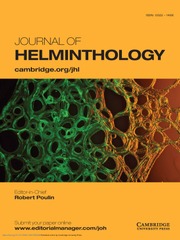No CrossRef data available.
Article contents
Previous hookworm infection attenuates the immune response to a subsequent Schistosoma mansoni infection in an experimental model
Published online by Cambridge University Press: 10 February 2025
Abstract
This study investigated the co-infection dynamics of Schistosoma mansoni and Ancylostoma ceylanicum in an experimental model. Two experiments were conducted to investigate varying infection orders. In experimental group 1, subjects were initially infected with A. ceylanicum, followed by S. mansoni infection. In group 2, subjects were first infected with S. mansoni, followed by A. ceylanicum infection. The co-infected groups were compared to mono-infected groups for further analysis. Parameters assessed included weight, fecal egg elimination, blood cell counts, IgG response, histopathological analysis, and granuloma morphometry. Results indicated that the timing of infections influenced weight loss. Co-infected animals lost weight similarly to A. ceylanicum-infected animals when A. ceylanicum preceded S. mansoni. The co-infected groups did not experience worsened anemia, despite both parasites being hematophagous. No linear correlation was found between S. mansoni egg counts and anti-SEA IgG production. The response to the S. mansoni adult worm antigen was significantly higher in the S. mansoni mono-infected group compared to the group previously infected with hookworm. Co-infection with A. ceylanicum after S. mansoni infection also interfered with the host response. It caused a delay in the peak of S. mansoni egg elimination compared to the S. mansoni monoinfected group. Additionally, fewer eggs were retained in the liver compared to single infections. These findings help elucidate the interactions between different parasites and their hosts in the same endemic area, providing valuable information to enhance strategies for disease control and management.
- Type
- Research Paper
- Information
- Copyright
- © The Author(s), 2025. Published by Cambridge University Press


